0 引言
1 样品及实验
1.1 岩心样品
表1 山西组典型致密砂岩样品的岩性、物性及孔隙发育特征Table 1 Lithology, physical properties and pore characteristics of typical tight sandstone samples from Shanxi Formation |
| 样品 编号 | 深度 /m | 层位 | 孔隙度 /% | 渗透率 /(10-3 μm2) | 岩性 | 孔隙类型及面孔率/% | 孔隙组合类型 | ||||
|---|---|---|---|---|---|---|---|---|---|---|---|
| 残余粒间孔 | 粒间溶孔 | 粒内溶孔 | 晶间孔 | 总面孔率 | |||||||
| 1# | 2 589.19 | 山2 | 5.90 | 0.892 0 | 石英砂岩 | 2.00 | 2.50 | 0.00 | 1.00 | 5.50 | 粒间孔—溶孔—晶间孔型 |
| 2# | 2 695.08 | 山1 | 11.17 | 0.560 7 | 岩屑石英砂岩 | 1.00 | 1.00 | 4.00 | 0.50 | 6.50 | 粒间孔—溶孔—晶间孔型 |
| 3# | 1 992.45 | 山2 | 9.10 | 0.454 0 | 岩屑石英砂岩 | 0.00 | 0.00 | 1.50 | 0.50 | 2.00 | 溶孔—晶间孔型 |
| 4# | 3 740.06 | 山1 | 11.29 | 0.474 8 | 石英砂岩 | 0.00 | 0.00 | 6.50 | 1.50 | 8.00 | 溶孔—晶间孔型 |
| 5# | 1 924.56 | 山1 | 12.50 | 0.327 5 | 岩屑砂岩 | 0.00 | 0.00 | 1.50 | 1.00 | 2.50 | 溶孔—晶间孔型 |
| 6# | 2 831.37 | 山1 | 11.87 | 0.491 0 | 岩屑砂岩 | 0.00 | 0.00 | 0.20 | 1.00 | 1.20 | 溶孔—晶间孔型 |
| 7# | 2 409.19 | 山2 | 2.68 | 0.093 0 | 岩屑砂岩 | 0.00 | 0.00 | 0.00 | 0.20 | 0.20 | 晶间孔型 |
| 8# | 2 196.48 | 山1 | 5.20 | 0.291 0 | 岩屑石英砂岩 | 0.00 | 0.00 | 0.00 | 0.20 | 0.20 | 晶间孔型 |
1.2 实验方法
2 实验结果和讨论
2.1 黏土矿物组成
表2 山西组典型致密砂岩样品的黏土矿物组成及含量Table 2 Types and contents of clay minerals occurred in typical tight sandstone samples of Shanxi Formation |
| 样品编号 | 黏土矿物相对含量/% | 伊/蒙间层比 | 黏土矿物绝对含量/% | |||
|---|---|---|---|---|---|---|
| 伊/蒙间层 | 伊利石 | 高岭石 | 绿泥石 | |||
| 1# | 31 | 33 | 36 | / | 10 | 3 |
| 2# | / | 41 | 18 | 41 | / | 14 |
| 3# | 19 | 7 | 73 | 1 | 10 | 13 |
| 4# | / | 23 | 44 | 33 | / | 10 |
| 5# | 3 | 26 | 35 | 36 | 20 | 17 |
| 6# | / | 37 | 16 | 47 | / | 20 |
| 7# | 6 | 83 | 2 | 9 | 40 | 27 |
| 8# | 8 | 47 | 12 | 33 | 20 | 18 |
2.2 微观孔喉特征
2.2.1 孔喉类型
图3 山西组典型致密砂岩样品的孔喉及黏土矿物特征(a)残余粒间孔和粒间溶孔,可见(弯)片状喉道,2#样品;(b)高岭石充填残余粒间孔,发育管束状喉道,2#样品;(c)粒间溶孔,可见片状喉道,1#样品;(d)粒内溶孔和晶间孔,可见管束状喉道,4#样品;(e)高岭石化碎屑和高岭石胶结物,发育晶间孔和管束状喉道,6#样品;(f)粒间充填的绿泥石和高岭石,5#样品;(g)伊利石晶间孔和管束状喉道,7#样品;(h)高岭石晶间孔和管束状喉道,8#样品;(i)粒间充填的伊利石,7#样品 Fig.3 Photomicrograph of pore-throats and clay minerals occurred in typical tight sandstone samples of Shanxi Formation |
2.2.2 孔喉半径分布
表3 山西组典型致密砂岩样品的恒速压汞实验参数Table 3 Parameters derived from the rate-controlled porosimetry tests of typical tight sandstone samples from Shanxi Formation |
| 样品编号 | 平均孔隙 半径/μm | 平均喉道 半径/μm | 平均 孔喉比 | 总进汞 饱和度/% | 孔隙进汞 饱和度/% | 喉道进汞 饱和度/% | 排驱压力/MPa | 孔隙组合类型 |
|---|---|---|---|---|---|---|---|---|
| 1# | 181.38 | 1.44 | 187.62 | 92.14 | 71.19 | 20.95 | 0.350 | 粒间孔—溶孔—晶间孔型 |
| 2# | 148.66 | 1.10 | 143.20 | 55.04 | 17.49 | 37.56 | 0.309 | 粒间孔—溶孔—晶间孔型 |
| 3# | 159.96 | 1.05 | 238.09 | 68.70 | 42.96 | 25.73 | 0.350 | 溶孔—晶间孔型 |
| 4# | 164.21 | 1.13 | 132.57 | 72.14 | 32.99 | 39.14 | 0.231 | 溶孔—晶间孔型 |
| 5# | 149.23 | 0.71 | 187.73 | 59.50 | 24.11 | 35.39 | 0.606 | 溶孔—晶间孔型 |
| 6# | 141.13 | 0.48 | 240.65 | 33.07 | 5.95 | 27.13 | 0.939 | 溶孔—晶间孔型 |
| 7# | 121.51 | 0.59 | 183.72 | 53.81 | 12.87 | 40.94 | 0.790 | 晶间孔型 |
| 8# | 127.30 | 0.30 | 435.67 | 52.57 | 30.18 | 22.40 | 0.897 | 晶间孔型 |
2.3 可动流体的分布特征
2.3.1 T 2谱曲线形态
2.3.2 可动流体参数
表4 山西组典型致密砂岩样品的核磁共振实验参数Table 4 Parameters derived from the nuclear magnetic resonance tests of typical tight sandstone samples from Shanxi Formation |
| 样品编号 | 核磁孔隙度/% | 渗透率/(10-3 μm2) | 可动流体百分数/% | 束缚流体百分数/% | T 2c/ms | 可动流体孔隙度/% |
|---|---|---|---|---|---|---|
| 1# | 4.67 | 0.892 0 | 78.79 | 21.21 | 90.39 | 3.68 |
| 2# | 11.53 | 0.560 7 | 40.10 | 59.90 | 7.32 | 4.62 |
| 3# | 9.14 | 0.454 0 | 58.86 | 41.14 | 22.09 | 5.38 |
| 4# | 11.34 | 0.474 8 | 67.44 | 32.56 | 3.95 | 7.65 |
| 5# | 12.58 | 0.327 5 | 47.00 | 53.00 | 10.16 | 5.91 |
| 6# | 11.67 | 0.491 0 | 22.07 | 77.93 | 3.37 | 2.57 |
| 7# | 2.56 | 0.093 0 | 9.41 | 90.59 | 5.17 | 0.24 |
| 8# | 4.86 | 0.291 0 | 9.39 | 90.61 | 8.76 | 0.46 |
2.4 储层微观特征对可动流体分布的影响
2.4.1 黏土矿物
2.4.2 孔喉特征
图8 山西组典型致密砂岩样品的可动流体百分数与平均孔隙半径、平均喉道半径及孔喉比的关系Fig.8 Relationship between MFS versus average pore radius, average throat radius and pore-throat radius ratio of typical tight sandstone samples from Shanxi Formation |
图9 山西组典型致密砂岩样品不同半径区间孔隙、喉道的累积频率分布Fig.9 Cumulative frequency of pore and throat in different radius interval of typical tight sandstone samples from Shanxi Formation |



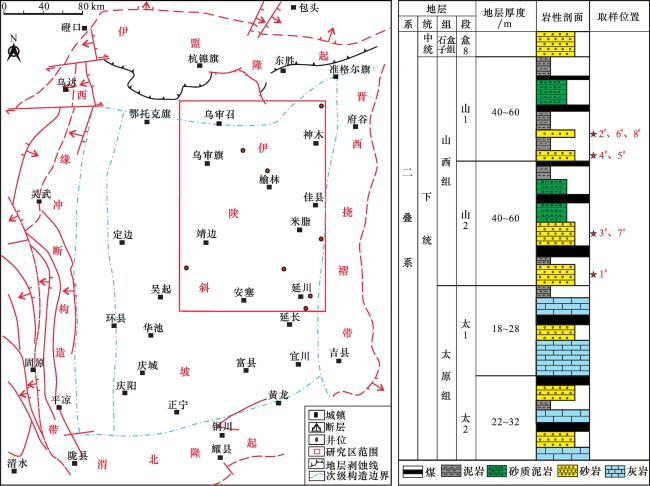
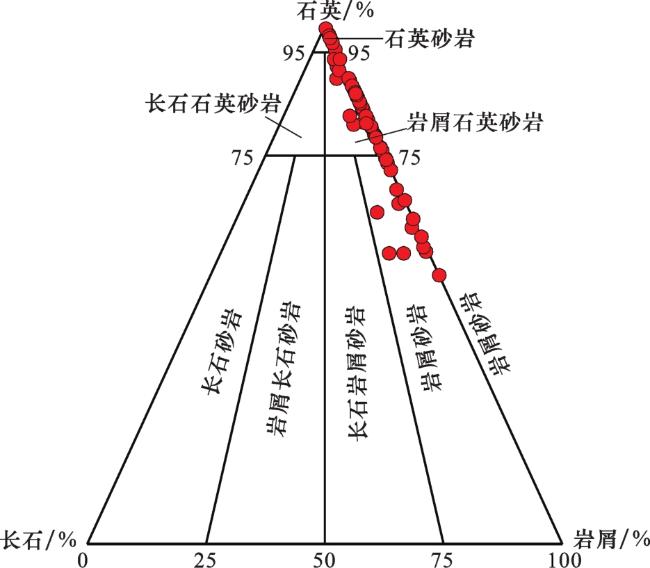
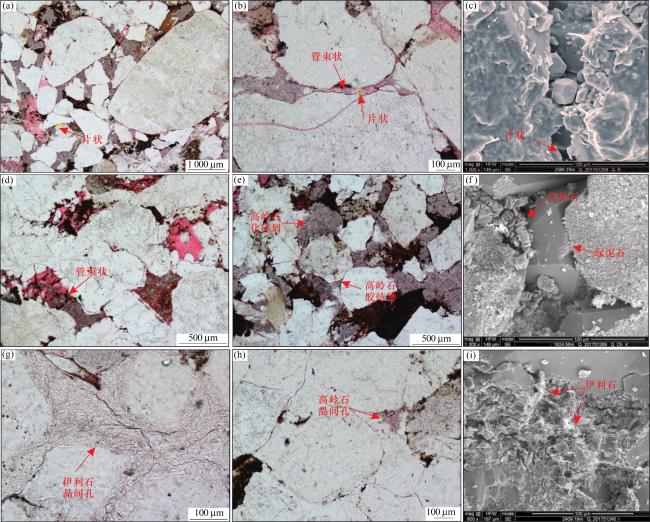
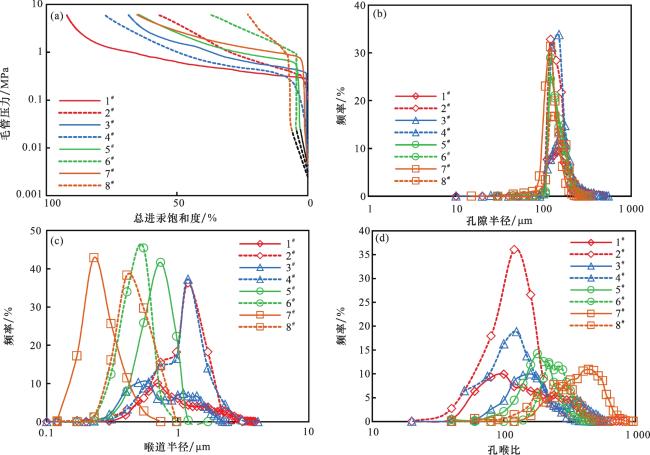
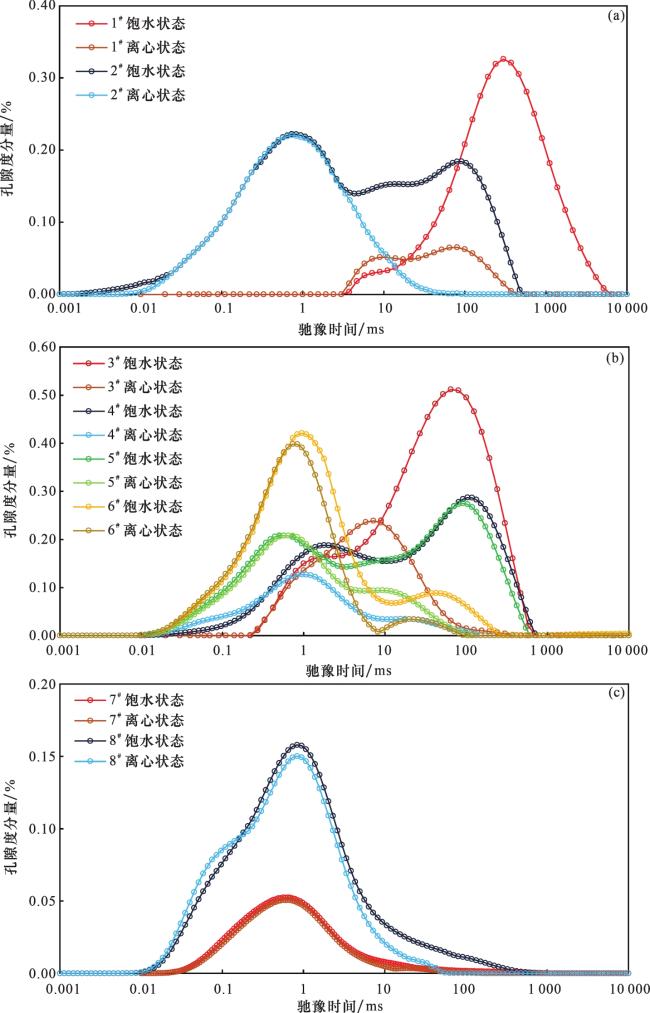
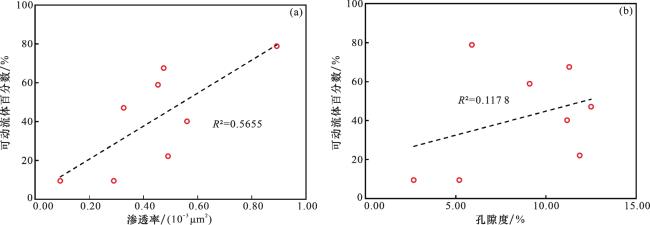

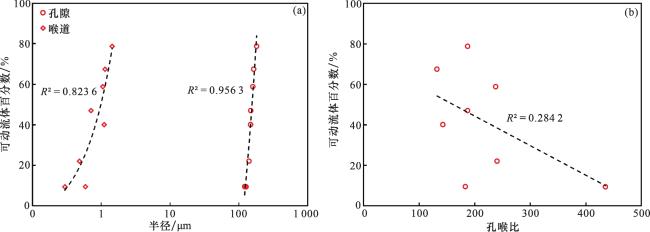

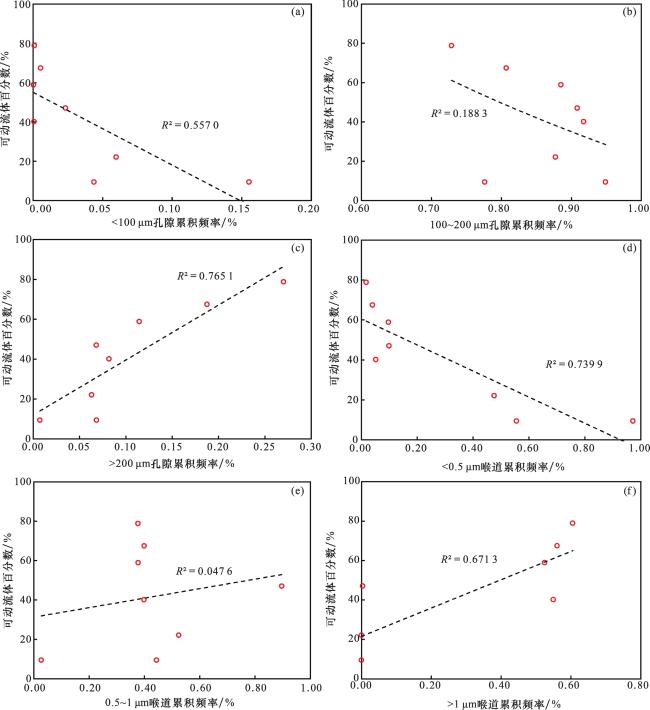
 甘公网安备 62010202000678号
甘公网安备 62010202000678号